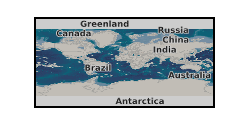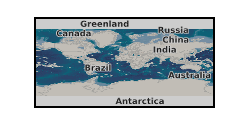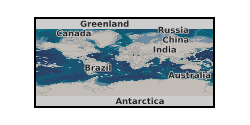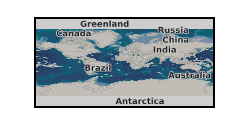2012
Type of resources
Available actions
Topics
Keywords
Contact for the resource
Provided by
Years
Formats
Representation types
Update frequencies
Service types
Scale
Resolution
-

Data identifying landscape areas (shown as polygons) attributed with geological names. The scale of the data is 1:25 000 scale. Onshore coverage is partial and BGS has no intention to create a national coverage at this scale. Areas covered are essentially special areas of 'classic' geology and include Llandovery (central Wales), Coniston (Lake District) and Cuillan Hills (Isle of Skye). Mass movement describes areas where deposits have moved down slope under gravity to form landslips. These landslips can affect bedrock, superficial or artificial ground. Another batch of tiles was added to the data in 2012 to bring the total to 167 for this version 2 release. Mass movement deposits are described in the BGS Rock Classification Scheme Volume 4. However the data also includes foundered strata, where ground has collapsed due to subsidence (this is not described in the Rock Classification Scheme). Caution should be exercised with this data; whilst mass movement events are recorded in the data due to the dynamic nature of occurrence significant changes may have occurred since the data was released. The data should therefore be regarded as a snapshot in time (as at 2008). The data are available in vector format (containing the geometry of each feature linked to a database record describing their attributes) as ESRI shapefiles and are available under BGS data licence. Another batch of tiles was added to the data in 2012 to bring the total to 167 for this version 2 release.
-

This dataset contains data from a marine geophysical and multibeam survey which took place in April 2012 in the area of Ardmucknish Bay on board the RV White Ribbon. This was a follow up survey to the previous work carried out in this area in 2011 (2011/4). QICS (Quantifying and monitoring potential ecosystem impacts of geological carbon storage) was a scientific research project funded by NERC; its purpose was to improve the understanding of the sensitivities of the UK marine environment to a potential leak from a carbon capture storage (CCS) system. The aim of the survey was to assess any affect the drilling of the borehole had on the underlying sediments. Sea floor bathymetry data were collected using a Kongsberg EM3002D multibeam system. Sub bottom seismic profiling data were collected using an Applied Acoustics surface tow boomer (STB). Technical details of the survey are contained in the BGS Report of Survey. Webpage www.bgs.ac.uk/QICS/. NERC Grant NE/H013954/1.
-

Full proposal for scientific drilling (852-CPP) 'GlaciStore: Understanding Late Cenozoic glaciation and basin processes for the development of secure large-scale offshore CO2 storage (North Sea)', submitted to Integrated Ocean Discovery Programme (IODP) April 2014. The proponent 'GlaciStore' consortium comprises research and industry organisations from the UK and Norway. The full proposal describes the relationship of the proposed research with the IODP science plan, regional background and previous work, and describes and illustrates three scientific objectives. The objectives are to investigate: glacial history and sedimentary architecture: fluid flow and microbial processes in shallow sediments; and the stress history and geomechanical models for strata that have experienced multiple glacial and interglacial cycles. The drilling and sampling strategy, standard drilling and logging operations, and the specialist measurements expected to be taken are described. Related initiatives and wider context of the proposed research also the initial and planned strategy for support from industry and government are outlined. The lead submitter, on behalf to the GlaciStore consortium is Heather Stewart, British Geological Survey (BGS).The 30 proponents from the UK and Norway (BGS, Institute for Energy Technology, Lundin Norway AS, SINTEF Energy Research, Statoil ASA, University of Bergen, University of Edinburgh and University of Oslo) and their expertise are listed. The full proposal is a pdf format file. This is restricted to the proponents for publication and to progress to a revised full proposal accepted for drilling by IODP. UKCCSRC Grant UKCCSRC-C1-30.
-

Revised full proposal cover sheet for scientific drilling (852-CPP2) 'GlaciStore: Understanding Pleistocene glaciation and basin processes and their impact on fluid migration pathways (North Sea)', submitted to Integrated Ocean Discovery Programme (IODP) April 2016. The full proposal cover sheet document is publicly available from IODP; the submitted full proposal document is restricted to the proponents for publication and for review and response from IODP. The proposal is a revision of full proposal 852-CPP in response to review by IODP. The lead submitter, on behalf to the GlaciStore consortium is Heather Stewart, British Geological Survey (BGS).The 32 proponents are from research and industry organisations in the UK, Norway, USA and Canada (BGS, Institute for Energy Technology, Lundin Norway AS, Memorial University of Newfoundland, SINTEF Energy Research, Statoil ASA, University of Bergen, University of Edinburgh, University of Oslo and University of Ottawa University of Texas at Austin). The revised full proposal cover sheet states the names of proponents of the 'GlaciStore' consortium and details for the lead submitter of the bid. The full proposal cover sheet comprises: an abstract of the submitted full proposal including description of project funding support as a Complementary Project Proposal: describes and states the scientific research objectives; summarises proposed non-standard measurements; tabulates details of the 13 proposed drill sites (revised from full proposal CPP-852) to address the scientific objectives. The objectives are to investigate: glacial history and sedimentary architecture; fluid flow and microbial processes in shallow sediments; and the stress history and geomechanical models for strata that have experienced multiple glacial and interglacial cycles. The table of revised proposed drilling sites includes designation of primary or alternate sites, the co-ordinates of the position and water depth at each proposed site, the objective for drilling and sampling and the depth to achieve the objective. The proponents, their affiliation, expertise and role for the submission are listed. UKCCSRC Grant UKCCSRC-C1-30.
-

The BGS has been commissioned by Defra to provide guidance on what are 'normal' levels of contaminant concentrations in English soils in support of the revision of the Part 2A Contaminated Land Statutory Guidance. The domain polygons and other data produced by this work are served as WMS here.
-

Carbon Capture and Storage (CCS) is a crucial technology to enable the decarbonisation of fossil fuel electricity generation. The UK has considerable potential for geological storage of CO2 under the North Sea and extensive offshore industry experience that could be applied. While initial storage is likely to be undertaken in depleted oil and gas fields, much larger saline aquifer formations are estimated to have sufficient capacity to securely contain 100 years of current UK fossil fuel power plant CO2 emissions. The CO2 Aquifer Storage Site Evaluation and Monitoring (CASSEM) project brings together the experience and different working practices of utilities, offshore operators, engineering contractors, and academic researchers to build collective understanding and develop expertise. CASSEM produced both new scientific knowledge and detailed insight into the CCS industry, developing best-value methods for the evaluation of saline aquifer formations for CO2 storage. Alongside work to assess the storage potential of two saline aquifer formations in close proximity to large coal power plant, CASSEM applied a novel Features, Events and Processes method to explore perceptions of risk in the work undertaken. This identified areas of industry and research community uncertainty and unfamiliarity to enable targeted investment of resource to reduce overall project risk. An openly accessible and flexible full chain (CO2 capture, transport and storage) costing model was developed allowing the CCS community to assess and explore overall costs. CASSEM's work also included the first use of citizen panels in the regions investigated for storage to assess public perception and educate the general public about CCS. CASSEM now plans to apply and further develop the methodologies established to test the viability of using a large offshore saline aquifer to store CO2 from multiple sources, leading to the proving of such a store by test injection of CO2.
-

Pre-proposal for scientific drilling 'GlaciStore: Understanding Late Cenozoic glaciation and basin processes for the development of secure large-scale offshore CO2storage (North Sea)', submitted to Integrated Ocean Discovery Programme (IODP) March 2014. The proponent 'GlaciStore' consortium comprises research and industry organisations from the UK and Norway. The pre-proposal describes the scientific research objectives, 12 proposed drill sites to address the objectives, the relationship of the research with the IODP science plan, and describes and illustrates three scientific objectives. The objectives are to investigate the glacial history and sedimentary architecture, fluid flow and processes, and the stress history and geomechanical response in strata that have experienced multiple glacial and interglacial cycles cycles. A drilling and sampling strategy and the measurements expected to be taken are also described The lead submitter, on behalf to the GlaciStore consortium is Heather Stewart, British Geological Survey (BGS).The 27 proponents from the UK and Norway (BGS, Institute for Energy Technology, Lundin Norway AS, SINTEF Energy Research, Statoil ASA, University of Bergen, University of Edinburgh and University of Oslo) and their expertise are listed. The pre-proposal is a pdf format file. This is restricted to the proponents for publication and to progress to full proposal to IODP. UKCCSRC Grant UKCCSRC-C1-30.
-
Digital Terrain Model (DTM) at 5 metre resolution (GB-wide) derived from photogrammetry (2008-2012).

The Digital Terrain Model (DTM) is a bare earth model, posted at 5m with a vertical accuracy of less than 60cm RMSE (root mean square error). The model represents the bare ground surface without any objects like trees and buildings. The dataset covers Great Britain. The first surface model, the Digital Surface Model (DSM), which represents the earth’s surface including all objects on the surface, is produced using the digital stereo aerial photography acquired by Getmapping. The DSM is edited to produce a 5m DTM product. A suite of algorithms have been applied to semi-automatically edit the DSM and remove unwanted surface features such as buildings and vegetation. These algorithms include a routine which reduces the woodland canopy areas based on a bounding polygon. This requires some manual intervention to create bounding polygons for woodland extents and identify true ground level. In addition, break lines are captured where required to ensure true terrain features are not removed and that bodies of water, such as lakes, remain flat. The PGA Elevation data offers improved spatial resolution compared to the NEXTMap data. The data is from the Pan Government Agreement (PGA) and an in-perpetuity license has been granted to BGS. The data is being managed by the Earth and Planetary Observation and Monitoring (EPOM) Team in support of the wider BGS Programme.
-

The hydrogeological map indicates aquifer potential in generalised terms using a threefold division of geological formations: those in which intergranular flow in the saturated zone is dominant, those in which flow is controlled by fissures or discontinuities and less permeable formations including aquifers concealed at depth beneath covering layers. Highly productive aquifers are distinguished from those that are only of local importance or have no significant groundwater. Within each of these classes the strata are grouped together according to age or lithology. The 1:625 000 scale data may be used as a guide to the aquifers at a regional or national level, but should not be relied on for local information.
-

The TellusSW project acquired airborne geophysical data for the counties of Cornwall and parts of Devon and Somerset during the second half of 2013. The maps of the geophysical data and their derivatives are provided to facilitate spatial comparison with, and modelling of, the soil, geological and environmental aspects of the data. The survey comprised a high resolution magnetic/magnetic gradient survey combined with a multichannel (256 channel) radiometric survey. The survey was carried out using 200 m (N-S) line separations at a mean elevation of 91 m. The survey provided 60,323 line-km of data.
 NERC Data Catalogue Service
NERC Data Catalogue Service